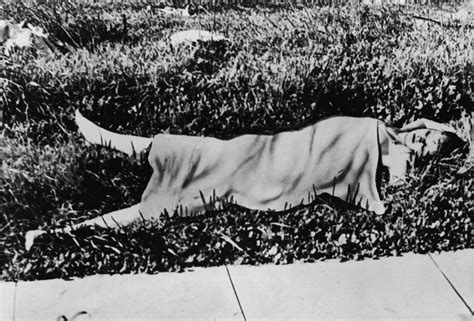The Black Dahlia crime scene is one of the most infamous and intriguing in American history. The brutal murder of 22-year-old Elizabeth Short in January 1947 shocked the nation and led to a massive investigation that remains one of the most extensive and puzzling in Los Angeles Police Department (LAPD) history. The crime scene, which was discovered on January 15, 1947, in a vacant lot on Norton Avenue in Leimert Park, Los Angeles, presented a gruesome and disturbing tableau that would haunt investigators and the public for decades to come.
Upon arrival, police officers found Short’s body mutilated beyond recognition, with evidence of severe torture, mutilation, and a gruesome post-mortem mutilation. The killer had severed Short’s body at the waist, removed her intestines, and carved a grotesque smile into her face, earning her the macabre nickname “The Black Dahlia.” The crime scene was meticulously staged, with Short’s body posed in a deliberate and ritualistic manner, suggesting a calculated and premeditated act of violence.
One of the most striking aspects of the crime scene was the lack of blood or other signs of struggle, leading investigators to believe that Short was killed elsewhere and then transported to the vacant lot. The area around the body was also surprisingly clean, with no signs of disturbance or evidence of the killer’s presence. This eerie sense of calm and control has been interpreted by some as a signature element of the crime, hinting at a highly organized and calculating perpetrator.
The LAPD’s investigation into the Black Dahlia murder was unprecedented in its scale and scope, involving hundreds of officers, countless interviews, and a vast array of forensic evidence. Despite the massive effort, the case remained unsolved, and the identity of the killer continues to be the subject of intense speculation and debate. Over the years, numerous suspects have been identified, and several have been accused of the crime, but none have been proven guilty beyond a reasonable doubt.
As the investigation unfolded, several key pieces of evidence emerged, including a cryptic letter sent to the LAPD, allegedly from the killer, and a series of bizarre and disturbing phone calls made to the police department. These communications, which included references to the murder and claims of responsibility, have been interpreted as a form of psychological manipulation, designed to taunt and confuse investigators.
In the decades since the Black Dahlia murder, numerous theories and suspects have emerged, each with its own strengths and weaknesses. Some have pointed to the involvement of organized crime figures, while others have suggested a link to the Hollywood film industry or the darker aspects of Los Angeles’s underbelly. Despite the many leads and tips, the case remains a puzzle, with the true identity of the killer and the motives behind the crime continuing to elude investigators.
One of the most fascinating aspects of the Black Dahlia case is the way it has captivated the public imagination, inspiring countless books, films, and documentaries. The crime has become a cultural touchstone, symbolizing the darker aspects of human nature and the mysterious, often disturbing, underside of Los Angeles. As a result, the Black Dahlia has become an enduring figure in American true crime lore, a haunting reminder of the violence and brutality that can lurk in the shadows of even the most seemingly ordinary communities.
In conclusion, the Black Dahlia crime scene represents a pivotal moment in American true crime history, a brutal and disturbing act of violence that continues to fascinate and haunt the public imagination. As investigators and researchers continue to examine the evidence and explore new leads, it’s essential to approach the case with a nuanced and balanced perspective, acknowledging both the tragic circumstances of the crime and the potential benefits and drawbacks of continued investigation and media attention.
What were the most significant challenges faced by investigators in the Black Dahlia case?
+The investigation was hindered by a lack of forensic evidence, inconsistent witness statements, and the sheer scale of the case, which involved hundreds of suspects and leads.
What is the current status of the Black Dahlia case, and are there any ongoing investigations or leads?
+While the case remains unsolved, the LAPD continues to receive tips and investigate new leads. In recent years, advances in forensic technology and DNA analysis have led to the re-examination of evidence and the identification of potential suspects.
What can be learned from the Black Dahlia case about the importance of forensic evidence and investigative techniques?
+The case highlights the critical role of forensic evidence in solving crimes, as well as the need for meticulous investigation and attention to detail. The Black Dahlia case also demonstrates the importance of adapting to new technologies and techniques, such as DNA analysis, to aid in the solving of cold cases.



